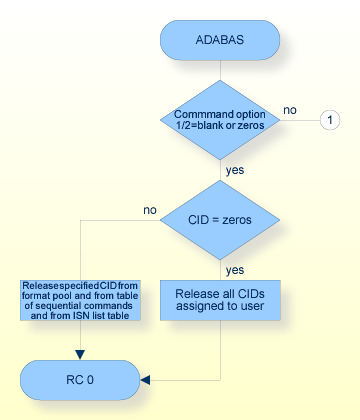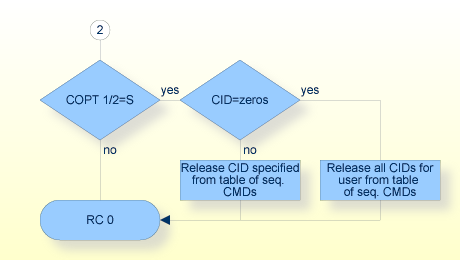This document covers the following topics:
The RC command is used to release one or more command IDs that are currently assigned to a user.
A command ID should be released under any of the following circumstances:
The user has completed the processing of an ISN list which is stored on the Adabas temporary working space as a result of an Sx command in which the SAVE ISN LIST option was used. This will permit Adabas to reuse the space currently occupied by the list;
The user wishes to terminate a sequential pass of a file (L2/L5, L3/L6, L9 command) before reaching an end–of–file condition;
The user has completed a series of L1/L4, A1, N1/N2 commands in which a non-blank command ID was used.



| Field | Format | |
|---|---|---|
| Call Type | B | F/U |
| Reserved (internal use) | -/- | |
| Command Code | A | F/U |
| Command ID | B | F/U |
| File Number | B | F/U (1) |
| Response Code | B | F/A (1) |
| Command Option 1 | A | F/U |
| Command Option 2 | A | F/U |
| Additions 2 | A,B | -/A |
| Additions 5 | A | F/U |
| Command Time | B | -/A |
| User Area | F/U |
| Buffer | |
|---|---|
| Format Buffer | –/– |
| Record Buffer | –/– |
| Search Buffer | –/– |
| Value Buffer | –/– |
| ISN Buffer | –/– |
| A | alphanumeric |
| B | binary |
| A | Filled in by Adabas |
| F | To be filled in by User |
| U | Unchanged after Adabas call |
| - | Not used |
(1) The meaning of this field depends on the value specified for "Call Type". See Calling Adabas, The Control Block for details.
RC
The local command ID or separate format buffer ID that is to be released is specified in this field. A value of binary zeros will release all of the command IDs currently assigned to the user.
Adabas returns the response code for the command in this field. Response code 0 indicates that the command was executed successfully.
These fields are used to indicate that a command ID is to be released from the internal format buffer pool, the ISN list table or the table of sequential commands. Information about each of the above tables is contained in Programming Considerations, Using Command IDs.
An `F' in either of these fields indicates that the command ID(s) is/are to be released if contained in the internal format buffer pool.
An `S' in either of these fields indicates that the command ID(s) is/are to be released if contained in the table of sequential commands.
An `I' in either of these fields indicates that the command ID(s) is/are to be released if contained in the ISN list table.
If both of these fields are set to blanks or binary zeros, the command ID(s) will be released from all of the above tables in which it is or they are present.
An `L' in either of these fields indicates that a global format buffer ID is to be released. The format buffer ID is provided in the Additions 5 field.
For some response codes, Adabas returns detailed information in this field. See Adabas Messages And Codes for further information.
This field is used to provide the global format buffer ID that is to be released if the command option 1/2 field contains an `L'.
The command ID X003 is to be released.
Command Code RC
Command ID X003 (command ID X003 to be released)
Command Option 1/2 bb (all CID types to be released)
All command IDs currently assigned to the user are to be released.
Command Code RC
Command ID 0x00000000 (binary zeros indicate that
(or ^X00000000) all command IDs are to be released)
Command Option 1/2 bb (all CID types to be released)
All of the command IDs assigned to the user and which are contained in the table of sequential commands or the internal format buffer pool are to be released.
Command Code RC
Command ID 0x00000000 (binary zeros indicate that
(or ^X00000000) all command IDs are to be released)
Command Option 1 F (F indicates that command IDs contained
in the internal format buffer pool are to
be released)
Command Option 2 S (S indicates that command IDs contained
in the table of sequential commands are
to be released)